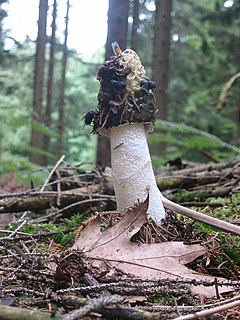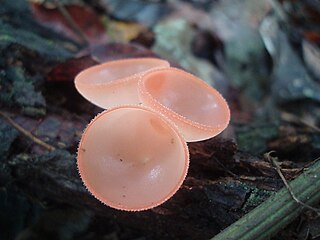An ascocarp, or ascoma, is the fruiting body (sporocarp) of an ascomycete phylum fungus. It consists of very tightly interwoven hyphae and millions of embedded asci, each of which typically contains four to eight ascospores. Ascocarps are most commonly bowl-shaped (apothecia) but may take on a spherical or flask-like form that has a pore opening to release spores (perithecia) or no opening (cleistothecia).

Phallaceae is a family of fungi, commonly known as stinkhorn mushrooms, within the order Phallales. Stinkhorns have a worldwide distribution, but are especially prevalent in tropical regions. They are known for their foul-smelling, sticky spore masses, or gleba, borne on the end of a stalk called the receptaculum. The characteristic fruiting-body structure, a single, unbranched receptaculum with an externally attached gleba on the upper part, distinguishes the Phallaceae from other families in the Phallales. The spore mass typically smells of carrion or dung, and attracts flies, beetles and other insects to help disperse the spores. Although there is great diversity in body structure shape among the various genera, all species in the Phallaceae begin their development as oval or round structures known as "eggs". According to a 2008 estimate, the family contains 21 genera and 77 species.

Cookeina is a genus of cup fungi in the family Sarcoscyphaceae, members of which may be found in tropical and subtropical regions of the world. Species may be found on fallen branches of angiosperms, trunks, and sometimes on fruits. The Temuans of Peninsular Malaysia are reported to use certain species from this genus as food, and also as a bait for fishing, where it is rubbed against the hook.

Scutellinia scutellata, commonly known as the eyelash cup, the Molly eye-winker, the scarlet elf cap, the eyelash fungus or the eyelash pixie cup, is a small saprophytic fungus of the genus Scutellinia. It is the type species of Scutellinia, as well as being the most common and widespread. The fruiting bodies are small red cups with distinct long, dark hairs or "eyelashes". These eyelashes are the most distinctive feature and are easily visible with a magnifying glass. The species is common in North America and Europe, and has been recorded on every continent. S. scutellata is found on rotting wood and in other damp habitats, typically growing in small groups, sometimes forming clusters. It is sometimes described as inedible, but its small size means it is not suitable for culinary use. Despite this, it is popular among mushroom hunters due to its unusual "eyelash" hairs, making it memorable and easy to identify.

Chorioactis is a genus of fungi that contains the single species Chorioactis geaster. The mushroom is commonly known as the devil's cigar or the Texas star in the United States, while in Japan it is called kirinomitake (キリノミタケ). This extremely rare mushroom is notable for its unusual appearance and disjunct distribution; it is found only in select locales in Texas and Japan. The fruit body, which grows on the stumps or dead roots of cedar elms or dead oaks, somewhat resembles a dark brown or black cigar before it splits open radially into a starlike arrangement of four to seven leathery rays. The interior surface of the fruit body bears the spore-bearing tissue known as the hymenium, and is colored white to brown, depending on its age. The fruit body opening can be accompanied by a distinct hissing sound and the release of a smoky cloud of spores.

Neofabraea is a genus of fungi in the family Dermateaceae. The genus contains 12 species.

Banksiamyces is a genus of fungi in the order Helotiales, with a tentative placement in the family Helotiaceae. The genus contains four species, which grow on the seed follicles of the dead infructescences or "cones" of various species of Banksia, a genus in the plant family Proteaceae endemic to Australia. Fruit bodies of the fungus appear as small, shallow dark cups on the follicles of the Banksia fruit. The edges of dry fruit bodies fold inwards, appearing like narrow slits. The first specimens of Banksiamyces, known then as Tympanis toomansis, were described in 1887. Specimens continued to be collected occasionally for almost 100 years before becoming examined more critically in the early 1980s, leading to the creation of a new genus to contain what was determined to be three distinct species, B. katerinae, B. macrocarpus, and B. toomansis. A fourth species, B. maccannii, was added in 1984.

Exidia glandulosa is a jelly fungus in the family Auriculariaceae. It is a common, wood-rotting species in Europe, typically growing on dead attached branches of oak. The fruit bodies are up to 3 cm (1.2 in) wide, shiny, black and blister-like, and grow singly or in clusters. Its occurrence elsewhere is uncertain because of confusion with the related species, Exidia nigricans.
Barcheria is a fungal genus in the family Agaricaceae. This is a monotypic genus, containing the single sequestrate species Barcheria willisiana, found in western Australia.
Cericium is a fungal genus in the family Cystostereaceae. It is a monotypic genus with the single species Cericium luteoincrustatum, a crust fungus. This species was originally described in 1986 by Kurt Hjortstam and Leif Ryvarden, who called it Amethicium luteoincrustatum. They placed it in the genus Amethicium based on microscopic similarities with the African species Amethicium rimosum.
Polytolypa is a monotypic genus of fungus containing the single species Polytolypa hystricis. First classified in the Onygenaceae family, as of 2008 it is considered to be in the Ajellomycetaceae, although there is still uncertainty as to its phylogenetic relationships with other similar genera. This species is only known from a single specimen derived in the laboratory from a specimen of dung of the North American porcupine, Erethizon dorsatum, collected in Ontario, Canada. Polytolypa hystricis contains bioactive compounds that have antifungal activity.

Mycena stylobates, commonly known as the bulbous bonnet, is a species of inedible mushroom in the family Mycenaceae. Found in North America and Europe, it produces small whitish to gray fruit bodies with bell-shaped caps that are up to 15 mm (0.6 in) in diameter. The distinguishing characteristic of the mushroom is the fragile stipe, which is seated on a flat disk marked with distinct grooves, and fringed with a row of bristles. The mushrooms grow in small troops on leaves and other debris of deciduous and coniferous trees. The mushroom's spores are white in deposit, smooth, and ellipsoid-shaped with dimensions of 6–10 by 3.5–4.5 μm. In the development of the fruit body, the preliminary stipe and cap structures appear at the same time within the primordium, and hyphae originating from the stipe form a cover over the developing structures. The mycelia of the mushroom is believed to have bioluminescent properties.
Margaretbarromyces is an extinct monotypic genus of pleosporale fungus of uncertain family placement. At present it contains the single species Margaretbarromyces dictyosporus.
Massarina carolinensis is a species of fungus in the Lophiostomataceae family. The species is found exclusively on the lower parts of the culms of the saltmarsh Juncus roemerianus on the Atlantic Coast of North Carolina.

Amylostereum is the single genus in the fungal family Amylostereaceae. The genus currently comprises four saprotrophic and parasitic species, which live off living or dead wood. The Amylostereaceae cause white rot in the wood by disintegrating the tissue component lignin. They produce crust-like, partially wavy fruit bodies on the surface of infested trees, which are similar to those produced by Stereum species.

Kalapuya brunnea is a species of truffle in the monotypic fungal genus Kalapuya. The truffle occurs only in the Pacific Northwest region of the United States, in western Oregon and northern California. Known locally as the Oregon brown truffle, it was formerly thought to be an undescribed species of Leucangium until molecular analysis demonstrated that it was distinct from that genus. The truffle is reddish brown with a rough and warty outer skin, while the interior spore-producing gleba is initially whitish before developing greyish-brown mottling as it matures. Mature truffles have an odor resembling garlicky cheese, similar to mature Camembert. The species has been harvested for culinary purposes in Oregon.

Coccomyces dentatus is a species of fungus in the family Rhytismataceae. A widespread species, particularly in temperate areas, it colonizes the dead fallen leaves of vascular plants, particularly oak and chestnut. The fungus apothecia, which form in the epidermal layer of the leaf host, resemble dark hexagonal spots scattered on a multi-colored mosaic pattern bounded by thin black lines. When mature, the apothecia open by triangular flaps to release spores. The anamorph form of C. dentatus is Tricladiopsis flagelliformis. Lookalike species can be distinguished by the shape of the apothecia, or by microscopic characteristics.

Hirticlavula is a fungal genus in the family Clavariaceae. It contains a single described species, Hirticlavula elegans. Formally described in 2014, the fungus has been collected from Norway and Denmark. H. elegans produces white fruit bodies up to 1.1 millimetres (0.043 in) in height. Each fruit body contains a fertile head atop a hairy stem. The fruit bodies grow directly from dead bark or wood, where they feed as saprotrophs. Both morphological and ecological details are distinctive when compared to other clavarioid fungi.
Ungulidaedalea is a fungal genus in the family Fomitopsidaceae. The genus was circumscribed by Chinese mycologists in 2016 to contain the single species Ungulidaedalea fragilis, a fungus that was described as new in 2014 with the name Fomitopsis fragilis. The holotype of this fungus was collected in Jianfengling Nature Reserve, in Ledong County (Hainan). The generic name Ungulidaedalea refers to the resemblance between this species and Daedalea, and also to the hoof-shaped (ungulate) form of the fruit body. Ungulidaedalea fragilis has rather fragile fruit bodies with a dark brown crust and large angular pores on the cap underside. Microscopic characteristics include its densely septated skeletal hyphae, and oblong-ellipsoid spores that measure 4–5.2 by 2.2–2.8 μm.
Pseudothielavia terricola is a fungal species of the phylum Ascomycota, family Chaetomiaceae, and genus Pseudothielavia. Pseudothielavia terricola is widely distributed, especially in the tropical region of the world – with documented appearances in Africa, Southern Europe, and Asia. The species is mainly found in soil, but can also be found on other materials such as animal dung. The species was first assigned to the genus Coniothyrium in 1927, but was soon re-assigned to the genus Thielavia which endured for almost 90 years. Through intensive phylogenetic research and reassessment, the species was designated to a new genus, Pseudothielavia; the etymology of Pseudothielavia means similar to the genus Thielavia – the high resemblance was what contributed to the species assignment to the genus Thielavia nine decades ago. The fungus is mesophilic, grows abundantly in a pH level between 3.9–6, and is able to utilize multiple carbohydrates to support its growth. Mature Pseudothielavia terricola colonies in culture is dark brown in colour and spread out. Pseudothielavia terricola synthesizes a variety of compounds, two of which are thielavin A & B. These compounds were determined to be strong inhibitors of prostaglandin synthesis.












